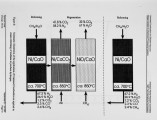| Title |
Unmixed Combustion for Efficient Heat and Mass aTransfer in Chemical Processing Systems |
| Creator |
Lyon, Richard K.; Cole, Jerald A. |
| Publisher |
University of Utah |
| Date |
1997 |
| Spatial Coverage |
presented at Chicago, Illinois |
| Abstract |
Unmixed Combustion, or UMC, is a cyclic, phase-heterogeneous technology for oxidizing fuels to produce useful heat without formation of undesirable pollutants. While relatively new in its development, UMC has already shown great promise for improving efficiency or effectiveness for a number of specific applications. The UMC process can be described simply as follows: A finely divided metal, when exposed to air, will oxidize with the production of heat. If the heated metal oxide is subsequently exposed to a gaseous or vapor-phase fuel such as syngas, methane, or petroleum distillates it will be reduced as the fuel is oxidized to produced carbon dioxide and steam. The complete process can be represented as follows: oxidation step: air + metal -> nitrogen + metal oxide + heat reduction step: metal oxide + fuel -> metal + CO2 + H2O + heat net process: air + fuel -> nitrogen + CO2 + H2O + heat Thus the net process simply involves the oxidation of fuel by the oxygen from the air with the same total heat release. Several issues distinguish UMC from other combustion processes. One is that the heat of oxidation is converted principally into sensible heat of the solid phase. This promotes effective conduction heat transfer. Another is that since the fuel and air do not mix there is no gas-phase chemistry that can result in NOx emissions. Through the selection of different metals several process specific parameters can be adjusted. These include the temperature range for the process and the distribution of heat release between the oxidation and reduction steps (the reduction step can even be endothermic). Finally, although UMC is a heterogeneous process fuel oxidation can be very complete, with experimental data showing only trace emissions of non-methane hydrocarbon (<<I ppm) and CO levels typically below 10 ppm. |
| Type |
Text |
| Format |
application/pdf |
| Language |
eng |
| Rights |
This material may be protected by copyright. Permission required for use in any form. For further information please contact the American Flame Research Committee. |
| Conversion Specifications |
Original scanned with Canon EOS-1Ds Mark II, 16.7 megapixel digital camera and saved as 400 ppi uncompressed TIFF, 16 bit depth. |
| Scanning Technician |
Cliodhna Davis |
| ARK |
ark:/87278/s67m0bj6 |
| Setname |
uu_afrc |
| ID |
13825 |
| Reference URL |
https://collections.lib.utah.edu/ark:/87278/s67m0bj6 |























